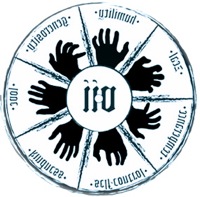Seven
7 (seven) is the natural number following 6 and preceding 8.
In mathematics
- Seven is the fourth prime number. It is not only a Mersenne prime (since 23 − 1 = 7) but also a double Mersenne prime since it is itself the exponent for another Mersenne prime (127). It is also a Newman-Shanks-Williams prime, a Woodall prime, a factorial prime, a lucky prime, a happy number, a safe prime and the fourth Heegner number.
- Seven is the lowest number which cannot be represented as the sum of the squares of three integers.
- Seven is the aliquot sum of one number, the cubic number 8 and is the base of the 7-aliquot tree.
- n = 7 is the first natural number for which the next statement does not hold: "Two nilpotent endomorphisms from Cn with the same minimal polynomial and the same rank are similar."
- 7 is the only dimension, besides the familiar 3, in which a vector cross product can be defined.
- 999,999 divided by 7 is exactly 142,857. Therefore, when a vulgar fraction with 7 in the denominator is converted to a decimal expansion, the result has the same six-digit repeating sequence after the decimal point, but the sequence can start with any of those six digits.[1] For example, 1/7 = 0.142 857 142.... and 2/7 = 0.285 714 285...
- A seven-sided shape is a heptagon. The regular n-gons for n ≤ 6 can be constructed by compass and straightedge alone, but the regular heptagon cannot. Figurate numbers representing heptagons (including seven) are called heptagonal numbers. Seven is also a centered hexagonal number.
- There are seven frieze groups, the groups consisting of symmetries of the plane whose group of translations is isomorphic to the group of integers.
- Seven is the sum of any two opposite sides on a standard six-sided die. When rolling two standard six-sided dice, seven has a 6 in 36 (or 1/6th) probability of being rolled (1–6, 6–1, 2–5, 5–2, 3–4, or 4–3), the greatest of any number.
Evolution of the Glyph
In the beginning, various Hindus wrote 7 more or less in one stroke as a curve that looks like an uppercase J vertically inverted. The western Ghubar Arabs' main contribution was to make the longer line diagonal rather than straight, though they showed some tendencies to making the character more rectilinear. The eastern Arabs developed the character from a 6-look-alike into an uppercase V-look-alike. Both modern Arab forms influenced the European form, a two-stroke character consisting of a horizontal upper line joined at its right to a line going down to the bottom left corner, a line that is slightly curved in some font variants. As is the case with the European glyph, the Cham and Khmer glyph for 7 also evolved to look like their glyph for 1, though in a different way, so they were also concerned with making their 7 more different. For the Khmer this often involved adding a horizontal line above the glyph. This is analogous to the horizontal stroke through the middle that is sometimes used in handwriting in the Western world but which is almost never used in computer fonts. This horizontal stroke is, however, important to distinguish the glyph for seven from the glyph for one in writings that use a long upstroke in the glyph for one.[1]
Quote
The Seven Master Spirits of Paradise are the primary personalities of the Infinite Spirit. In this sevenfold creative act of self-duplication the Infinite Spirit exhausted the associative possibilities mathematically inherent in the factual existence of the three persons of Deity. Had it been possible to produce a larger number of Master Spirits, they would have been created, but there are just seven associative possibilities, and only seven, inherent in three Deities. And this explains why the universe is operated in seven grand divisions, and why the number seven is basically fundamental in its organization and administration.
See also
References
- Wells, D. The Penguin Dictionary of Curious and Interesting Numbers London: Penguin Group (1987): 70–71
